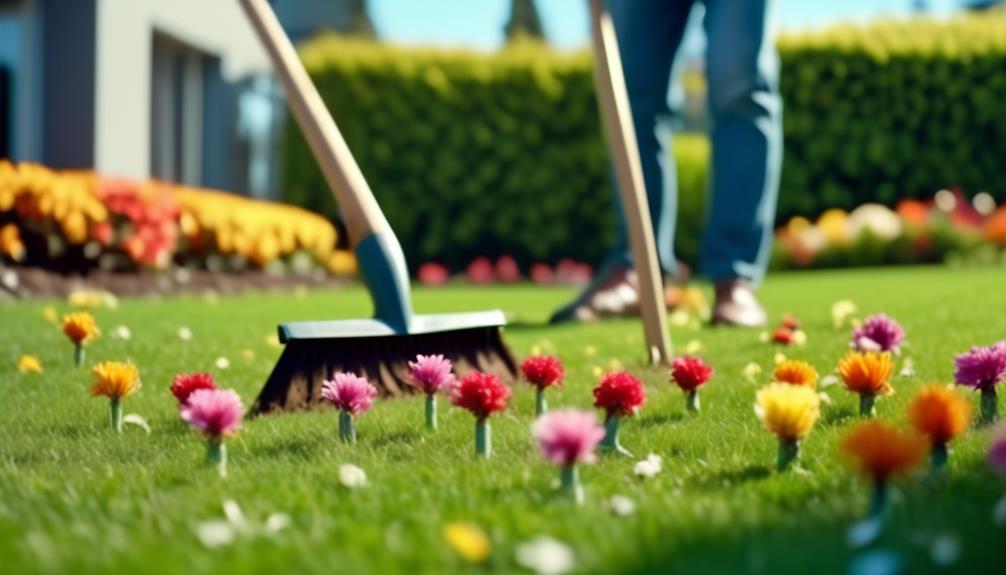As the first buds of spring begin to unfurl, our yards awaken from their winter slumber, signaling the start of a new season of yard maintenance. Living in London, I’ve learned the ins and outs of keeping a yard in top shape throughout the year. From navigating the ever-changing weather to understanding the unique needs of local flora, maintaining a yard in London requires a tailored approach.
Whether you’re new to homeownership or just looking to up your yard care game, this guide will provide you with practical tips and detailed insights to help you tackle seasonal maintenance with confidence.
So, let’s start with the essential tasks for spring yard cleanup and set the foundation for a year of thriving green spaces.
Key Takeaways
- Proper yard maintenance is essential for creating a healthy and vibrant outdoor space throughout the seasons.
- Each season requires specific tasks, such as clearing out flower beds in spring, watering and fertilizing in summer, preparing the garden in fall, and protecting the yard in winter.
- Conducting soil testing and adjusting nutrient levels is crucial for maintaining optimal soil quality and promoting plant health.
- Regular monitoring for pests and diseases, along with implementing integrated pest management strategies, is important to keep the yard healthy and prevent damage.
Spring Yard Cleanup
As a London homeowner, I find that spring yard cleanup is an essential task to maintain the overall health and appearance of my yard.
One of the first things I tackle is clearing out the flower beds. I start by removing any dead foliage and debris that has accumulated over the winter. This helps to prevent the growth of mold and disease, allowing my flowers to thrive.
Once the flower beds are tidy, I turn my attention to mulch application. Mulch not only gives the flower beds a neat, uniform appearance, but it also helps to retain moisture, suppress weeds, and regulate soil temperature. I make sure to apply a layer of mulch that’s around 2-4 inches thick, being careful not to pile it up against the stems of the plants.
This process not only enhances the aesthetic appeal of my yard but also provides a nourishing environment for my plants to flourish.
Taking the time to tend to these details during my spring yard cleanup sets the stage for a vibrant and healthy outdoor space throughout the season.
Summer Lawn Care Tips
Once the summer season arrives, I prioritize maintaining my lawn’s health and appearance through a combination of regular mowing, watering, and fertilizing. Proper watering techniques are crucial during the summer months to ensure the grass stays healthy and green. I typically water my lawn deeply and infrequently, usually in the early morning to minimize evaporation. This helps the roots to grow deeper, making the grass more resilient to heat and drought. Additionally, I adjust the frequency of watering based on weather conditions, ensuring not to overwater or underwater.
When it comes to fertilizing, I follow a schedule to keep my lawn nourished throughout the summer. I apply a slow-release nitrogen-rich fertilizer at the beginning of the season, followed by a lighter application in mid-summer to sustain growth. This schedule helps to maintain the lawn’s vibrancy and combat any stress caused by the summer heat.
Below is a table summarizing my summer lawn care routine:
| Task | Frequency | Best Time |
|---|---|---|
| Mowing | Weekly | Early morning or eve |
| Watering | Deep & infrequent | Early morning |
| Fertilizing | Beginning & mid-summer | Early morning or evening |
Fall Garden Preparation
Preparing your garden for fall involves a systematic approach to ensure a smooth transition for your plants and lawn. Firstly, soil testing is essential at this time to determine its nutrient levels and pH. This allows you to adjust the soil accordingly before the winter sets in. You can easily conduct a soil test using DIY kits available at local gardening stores, or by hiring a professional. Once you have the results, you can add necessary fertilizers or nutrients to the soil to improve its quality.
Additionally, leaf mulching is a great practice for fall garden preparation. Instead of raking and disposing of fallen leaves, consider mulching them with a lawnmower and leaving them on the ground. This won’t only save you time and effort but also provide valuable nutrients to the soil as the leaves decompose. It acts as a natural fertilizer and helps in retaining moisture, thus benefiting the overall health of your garden.
As a seasoned gardener, I’ve found these practices to be highly effective in ensuring that my garden stays healthy through the fall and into the winter months.
- What Are Easy Low-Maintenance Yard Design Ideas?
- 6 Best Eco-Friendly Yard Design Tips for a Sustainable Landscape
- Creative Small Yard Landscaping Ideas for Urban Homes
- What Are the Best Child-Friendly Yard Designs?
- 13 Stunning Modern Minimalist Yard Designs
Winter Yard Protection
When winter approaches, I proactively protect my yard by covering delicate plants with frost cloths and insulating the soil with a thick layer of mulch to safeguard against freezing temperatures and frost heaving. This ensures that my plants have the best chance of surviving the harsh winter conditions. Additionally, I implement effective snow removal strategies to maintain the safety and aesthetic appeal of my yard.
| Winter Plant Care | Snow Removal Strategies |
|---|---|
| Cover delicate plants with frost cloths | Shovel snow promptly to prevent ice formation |
| Insulate soil with a thick layer of mulch | Use snow blowers for large snow accumulations |
| Prune and trim trees and shrubs to remove weak or damaged branches | Apply eco-friendly de-icing agents to prevent slippery walkways |
Winter plant care is crucial for preserving the health and vitality of the yard. By taking these proactive measures, I ensure that my yard remains resilient throughout the winter months, ready to flourish once spring arrives.
Year-Round Maintenance Checklist

After ensuring my yard’s protection during winter, I continue to maintain its health and appearance year-round through a comprehensive maintenance checklist.
Firstly, I prioritize soil testing to assess its pH levels and nutrient content. This helps me determine the necessary fertilizers and soil conditioners for each season, ensuring that my plants receive the best possible care.
Additionally, I regularly check for signs of pests and diseases, promptly addressing any issues through targeted pest control methods. By staying vigilant, I can prevent potential damage and maintain a thriving yard throughout the year.
When it comes to soil testing, I use DIY kits for quick results, or I send samples to professional labs for more comprehensive analysis. Understanding my soil’s composition empowers me to make informed decisions about plant selection and soil amendments.
As for pest control, I implement integrated pest management strategies, which include natural predators, beneficial insects, and organic treatments to keep pest populations in check without harming the environment. Moreover, I regularly inspect my yard for any signs of pest infestations, enabling me to take swift action when needed.
This proactive approach helps me maintain a healthy and vibrant yard, ensuring that my outdoor space remains an enjoyable retreat year-round.
Frequently Asked Questions
How Can I Attract More Wildlife to My Yard During Different Seasons?
To attract more wildlife to my yard during different seasons, I use seasonal gardening techniques like planting native flowers, providing water sources, and creating shelter. These efforts have brought a variety of birds, butterflies, and insects to my garden.
What Are Some Common Pests and Diseases to Watch Out for in London Yards?
I’ve encountered common pests and diseases in London yards. Prevention is key, including regular checks for signs, proper plant care, and good hygiene. Control methods vary, but early intervention is crucial for healthy yards.
Are There Any Specific Regulations or Restrictions for Yard Maintenance in London?
In London, yard maintenance is subject to specific regulations and restrictions outlined in local ordinances. It’s important to be aware of these rules to ensure that your maintenance practices align with the city’s green spaces requirements.
How Can I Incorporate Sustainable and Eco-Friendly Practices Into My Seasonal Yard Maintenance?
I incorporate eco-friendly practices into my seasonal yard maintenance by using natural fertilizers, planting native species, and mulching. Sustainable landscaping methods like rainwater harvesting and composting help me reduce water usage and waste.
What Are Some Unique Challenges That London Homeowners Face When It Comes to Yard Maintenance?
Seasonal weather in London brings unique challenges like heavy rainfall and unpredictable temperature changes. Urban gardening in limited spaces demands creative solutions. I’ve found that raised beds and vertical gardening help maximize small yards.
Conclusion
As a London homeowner, maintaining your yard throughout the seasons is essential for a healthy and vibrant outdoor space. By following this seasonal yard maintenance guide, you can keep your yard looking its best year-round.
From spring cleanup to winter protection, these practical tips will help you tackle any yard maintenance task with ease and confidence.
With a little bit of effort and attention to detail, your yard will be the envy of the neighborhood.

